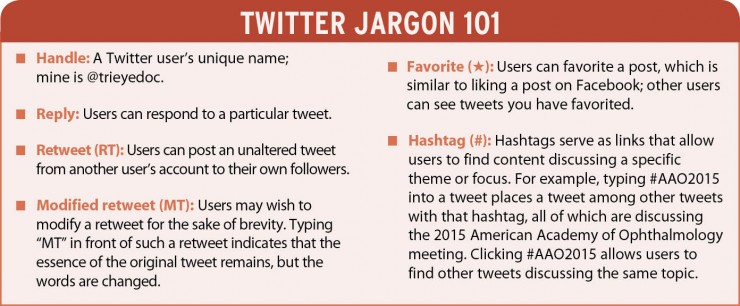I am constantly asked why I spend time on Twitter. “Isn’t Twitter for posting what you are doing or for following celebrities?” they ask. Oh, boy. Where do I start?
TWITTER BASICS
The ubiquity of the Internet and mobile devices has revolutionized the access and availability of medical information. Recent research has shown that physician adoption and use of smartphones in their professional lives hovers in the mid-80%, whereas tablet use sits at an estimated 53%.1

Social media, specifically Twitter, provides an open forum for enhanced learning, sharing, and engagement. For those not familiar with Twitter, it is a social media platform where concise messages, or tweets, are limited to 140 characters. As a result, ideas and content must be engaging and to the point, as users take little time to read or post.
This concise method of communication is perfect for a busy surgeon. Photos, messages, videos, and links can be added to each tweet to enhance the content. Users decide which Twitter profiles they want to follow. After choosing to follow a particular profile, users’ timelines automatically update based on the most recent activity of those they follow. Users also have the option to interact with other users’ tweets by replying, retweeting, modifying and retweeting, and favoriting tweets on their Twitter feed.
Twitter users can engage the Twittersphere on their own terms. Users might wish to simply follow particular accounts, staying behind the scenes and never tweeting. Alternatively, users can be active, tweeting to their followers and curating content based on their specific interests.
For example, I have an obvious love for all things retina, but I also have an interest in digital and mobile health technologies. Thus, the content I post—be it via tweets I write, tweets I retweet, or tweets I favorite—relates to these topics. Posted content comes from multiple sources, including peer-reviewed journals, websites, hospitals, industry, colleagues’ research, and colleagues’ original thoughts. Content can also come from attendance at meetings and chats, which are synchronous or asynchronous chats on Twitter concerning a specific topic and often hosted by a designated moderator.
RESEARCH
Twitter allows a physician to share research—whether personal or from a group of colleagues—to a wide audience. Posting links from journals or magazines to your followers promotes this work. Additionally, Twitter allows users to keep current with research in their field and other disciplines.
It is hard enough to keep current with research in your specialty; it is even harder to keep current in other areas of interest. Twitter solves this by allowing you to follow influencers, Twitter users who are leaders in posting specific content in a field of interest. For example, for my interest in digital and mobile health, I follow @EricTopol and @Paul_Sonnier for up-to-date information on the latest news in digital health technologies. Other fields, such as cardiology, oncology, medical IT, and business development, have their respective influencers. These key influencers post high-yield information and topics, information from which can then be applied to your specific interests or research.
Another feature of Twitter that I love is the ability to remotely attend conferences. As a retina specialist in my first year of practice, it is often difficult to attend the major annual meetings hosted by the American Academy of Ophthalmology (AAO), the American Society of Retina Specialists (ASRS), and the Association for Vision in Research and Ophthalmology (ARVO), let alone the smaller annual meetings such as that of the Vit-Buckle Society (VBS).
Alas, some doctors must be on call and are unable to attend these meetings. However, these conferences will register a hashtag (eg, #AAO2015), allowing attendees to post content about the meeting to a particular corner of the Twittersphere, thus enhancing the conference experience and stimulating interaction between physical and virtual attendees.
Despite being many miles from the meeting, I have access to lecture summaries, key talking points, and updates that are posted on Twitter. I have even used Twitter to ask questions to presenters at meetings. Following accounts that are active at meetings and engaging them will enhance your meeting experience while sitting in sessions or, if you are unable to attend, they will serve as a newswire of updates.
ONLINE REPUTATION
We live in a digital era in which patients and providers are comfortable navigating online. As a result, patients have become savvy consumers of health care, researching their ailments, treatments, and potential doctors. Websites such as Yelp, HealthGrades, and ZocDoc allow patients to search basic information about physicians, such as their training, office locations, and accepted insurances. However, these sites also allow patients to post reviews of their experiences in the clinic with a specific provider. Your online reputation is out of your control to some extent, but providing the best experience for every patient increases the likelihood that your online reputation will reflect positively. Thus, it is important for physicians to focus on building their online reputations independent of consumer-focused sites.
Twitter accounts can connect you to both colleagues and patients. Posting content that patients may find helpful will enhance your online reputation in the community as an innovative, cutting-edge thinker. Consider taking control of your online reputation and presence before someone else does so without you.
NETWORKING
Curating your online reputation can also help garner increased visibility among special interest groups, companies, and startups. Through my activity on Twitter, I have connected with experts across multiple disciplines and have had the opportunity to contribute guest articles to several reputable online sites. Additionally, several companies and startups have contacted me on Twitter to set up meetings for me to consult and provide input on new technologies. Similar to publishing journal articles and presenting at meetings, online networking can contribute to your visibility and reputation with the possibility of advancing your career.
FINAL THOUGHTS
Ophthalmologists have a passion for their work, and it is not surprising that their love for ophthalmology bleeds into social media. Like every Twitter user, those in ophthalmology access their feeds via computers, smartphones, and tablets, doing so while standing in the grocery store checkout line or waiting to board a flight for an upcoming meeting. Use this time to engage your colleagues. The results can only be positive.
1. Epocrates. Epocrates 2013 Mobile Trends Report. Maximizing multi-screen engagement among clinicians. www.epocrates.com/sites/default/files/2013_Epocrates_Mobile_Trends_Report_FINAL.pdf. Accessed August 17, 2015.


